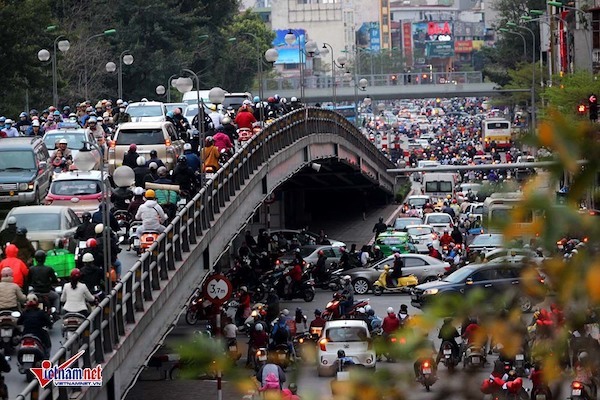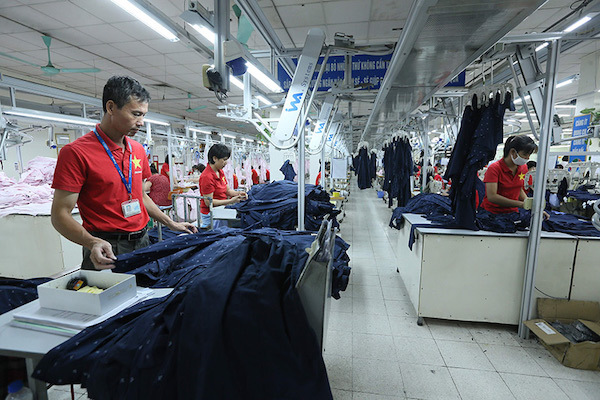According to the draft report on the socio-economic development strategy in 2021-2030, which has been published for public comment, in the 2011-2020 period, Vietnam obtained many achievements. After 35 years of renovation, Vietnam's power and position have grown in terms of scale and potential; the competitiveness and the autonomy of the economy has improved; more experience in leadership, direction and administration of socio-economic development has accumulated.
As a result, the macro-economy has basically stabilized, and the confidence of the business community and society has increased. The quality of growth has improved, increasing the openness of the economy and attracting large foreign direct investment. The private sector has become an increasingly important driving force for the country's economic development.
The socio-political system has been stable, the middle class has rapidly increased, and people's living standards have improved. Aspirations for a prosperous Vietnam, the spirit of self-reliance, is the endogenous strength for the country to develop rapidly and sustainably in the next 10 years (2021-2030).
However, shortcomings and limitations existed in the implementation of the development strategy in the 2011-2020 period. The risk of lagging behind is still great while the fundamental factors such as institutions, infrastructure, human resources ... to turn Vietnam into a modern industrial country… are still low compared to the requirements.
 |
|
In the 2021 - 2030 period, it is necessary to renew thinking, accelerate institutional reform, and apply scientific and technological advances, innovation and digital transformation.
|
The level of science and technology, productivity, efficiency and competitiveness is still low; the capacity to access the digital economy and digital society remains limited. GDP growth tends to slow down, the risk of falling into the middle income trap and falling behind remains. The rapid urbanization process creates great pressure on the need for infrastructure development and treatment of environmental pollution.
In addition, the task of defending independence and sovereigntyand ensuring national security faces many difficulties and challenges.
Three strategic breakthroughs
To overcome these limitations, the draft socio-economic development strategy for the period 2021 - 2030 states that it is necessary to renew thinking, change the way of working, the way of life, promote institutional reform, and apply modern sci-tech and digital transformation.
Assoc. Prof, Dr. Bui Tat Thang, a permanent member of the Editorial Group of the Economic and Social Subcommittee, said that Vietnam aims to achieve an average GDP growth rate of about 7 percent per year, GDP per capita by 2025 to reach $4,700-5,000, and about $7,500 by 2030.
Thang said in the next 10 years, Vietnam will focus on three strategic breakthroughs, including:
Firstly, continue to improve the quality of a complete, synchronous, modern and integrated socialist-oriented market economy institution, focusing on markets for factors of production, especially the market of land use rights, science and technology.
Secondly, continue to comprehensively develop human resources, science, technology, and innovation associated with arousing aspirations for national development, national pride, self-reliance and promoting the values of Vietnamese culture and Vietnamese people.
Thirdly, continue to improve synchronous and modern economic and social infrastructure, focusing on the development of key infrastructure in transport, energy, information technology, big cities, and infrastructure to respond to climate change.
Fair playing field
Commenting on the draft at a recent workshop held in Hanoi, experts at the World Bank (WB) in Vietnam said that it is necessary to review and evaluate the current legal regulations to ensure there are no overlaps creating unintended congestion for businesses and people. In addition, it is necessary to improve accountability and enhance transparency for people in monitoring and implementing policies.
 |
|
The private sector's contribution to Vietnam’s GDP by 2030 is expected to reach 60-65% compared to the current rate of 43%
|
The WB experts praised the draft strategy for not mentioning that the state sector plays a leading role in the economy and for focusing on market forces in resource allocation. The draft states that state-owned enterprises will be maintained as important actors in the state-owned economy. This is to ensure a level playing field between state-owned enterprises and the private sector, focusing on the development of the domestic private sector and making this sector a real engine of economic development.
The target for the private sector contribution to GDP by 2030 is 60-65% which is ambitious compared with the current rate of 43%. This means that the public sector’s contribution to the national GDP will decrease significantly, assuming that FDI continues to play an important role in the economy. Therefore, the strategy should include the goals on SOE reforms.
In addition, it is recommended to replace the current target "the private sector’s total contribution to GDP is between 60-65%" with the registered contribution of the domestic private sector, maybe from about 10% of GDP at present to 25% of GDP by 2030. This will reflect a focus on domestic firms, not only on the goal of having 2 million enterprises, but also on having powerful private groups, which are competitive in the region and in the world. In addition, this would indicate a qualitative change in terms of the size of private firms.
Achieving this goal, along with other GDP targets, means that the average added value created by a private enterprise will double by 2030, thereby overcoming the small-scale problem of local enterprises, a major reason for the limited linkage between FDI enterprises and the domestic sector.
Although there is a need to overcome the effects of the Covid-19 pandemic, it seems that the focus of the draft strategy is on the short-term effects of the pandemic. However, this impact is expected to last long and the WB experts said that the draft will be more complete if it is possible to expand the scope of Covid-19 pandemic to include necessary changes in the pandemic-induced growth pattern.
For the Covid-19 epidemic, specific tourism targets (47-50 million international tourists and 14-15% of GDP by 2030) may need to be reviewed.
 |
|
Implementing fiscal decentralization so that local governments can manage urbanization pressure.
|
The draft targets the industrial manufacturing industry to generate per capita income of $2,000 by 2030. Compared to the current number of $900, this represents nominal growth of 8.3%, which is quite low compared to the overall GDP growth target.
For the tourism industry, as activities cover many different service sectors, there is no single code. As a result, the goals set for this industry will be difficult to track and evaluate unless a clear definition of the industry is in place.
Regarding the FDI strategy, it can be extended to include changing investment incentives from pre-investment to post-investment and focusing on performance-based incentives. Industrial zones should be developed on the basis of specialization and advantages of the province, taking into account linkages, connections between provinces, and regional coordination capacity of provinces and the regions. Industrial zones need to accelerate the formation of industrial clusters and domestic value chains.
Traffic restructuring, fiscal decentralization
Traffic is also one of many concerns in Vietnam. Developing a clean transport system can reduce greenhouse gas emissions and strengthen green growth solutions.
The transport industry can consider the following solutions. First, restructuring to improve the efficiency of the transport system and promote the transport of goods from road to means of transport that are more fuel-efficient and have less emissions (such as waterways and railways). Second, promoting the development of public passenger transport by buses in urban areas; speeding up the investment and putting into operation the urban railway and bus routes in Hanoi and Ho Chi Minh City. Third, promoting the use of biofuels and clean fuels for motor vehicles ...
Regarding regional economic development, the target for the local government will also be raised with a clearer definition of roles and responsibilities between the central and local levels. Local and regional economic development will be more closely linked to promote advantages of localities. In addition, clearly delineating revenues and expenditures of all levels of the budget to enhance the leading role of the central budget, while ensuring autonomy, self-responsibility, encouraging and promoting the creativity of local governments.
However, for decentralization to be truly effective, there should be three additional reforms that need to be implemented by 2030.
Firstly, implementing fiscal decentralization so that local authorities can manage urbanization pressure. Local governments, especially large cities like Hanoi and Ho Chi Minh City, must keep at least 50% of locally generated revenues.
Secondly, simplifying the annual planning and budget exchange process between the central and local governments and adopting a more transparent and predictable budget transfer formula.
Finally, the system of incentives for local governments should be changed from a hierarchy based on GDP and large-scale infrastructure investments to operational efficiency and accountability.
Lan Anh

The need for talented people
The 13th Party Congress is an important milestone, which sets the future orientation, continues to accelerate the process of national renovation and international integration.

How to attract talent
VietNamNet introduces an article by National Assembly Deputy Le Thanh Van on the draft national strategy to attract and use talents, which can be seen as comments to the draft documents of the 13th National Party Congress.